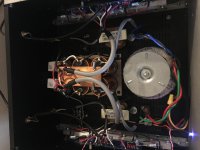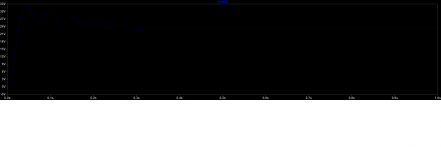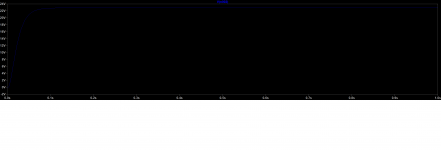Just measured my f5 with 6x 47000uf and Hammond 159zl psu. Ripple is .5mv.
That's impressive.My F7ish with 36Kuf/0.11R/36Kuf per polarity measures 46mv RMS.Funny,a sim I built using my values measures 2mv RMS ripple using 159zl specs. That's fairly close.Thanks for the info.
I had a quick search and didn't find the info I was after.
Are their any guide lines as to the inductance and dcr of the inductor to use in any given CLC supply ?
Ta.
Are their any guide lines as to the inductance and dcr of the inductor to use in any given CLC supply ?
Ta.
The Mighty ZMod has spoken, and his words of wisdom shall be abided by 🙂
Many thanks and have an awesome day 🙂
Many thanks and have an awesome day 🙂
...guide lines as to the inductance and dcr of the inductor to use in any given CLC supply ?...
Try to aim for 20mH-100mH, near 1 Ohm. (Less will ring, more is distressing voltage drop.)
Try to aim for 20mH-100mH, near 1 Ohm. (Less will ring, more is distressing voltage drop.)
We have 2 differing opinions here.Anybody care to chime in.
Well,I have installed 2 Hammond 159ZL,10mH,5A,0.16 ohm chokes in my amp.Ripple went from 46mv rms to 4mv rms (Fluke 8060A meter).As far as sound I have to say that the bass has more authority,amp seems to have more cojones.I just did the swap yesterday and have to spend more time listening for a more complete assesment.But definetly bass stood out immediately.
The sound is very different. Have only tried coreless inductors and yes, my preference goes for CLC, but others seem to prefer the freer, less controlled presentation of CRC. As usual, no universal recipe.
Just in case someone is reading this again - like me. Yes CLC will ring without a little series resistance, which your amplifier might not like. You can easily simulate it in LT-Spice for your specific PSU. For 2.5mH and around 100mF you want around 0.2 Ohms 20+ Watt resistor. The 44 mOhms of a 159ZL is too little in my case. Higher inductance will give you even better ripple but you will also need more resistance and generate lots of heat.
Attachments
Hello ozorfis
Ineresting finding.
This is some tome ago, but if you still have the .asc file you used for this, would you mind sharing it.
Ineresting finding.
This is some tome ago, but if you still have the .asc file you used for this, would you mind sharing it.
I recently rebuilt the PSU in my M2x. Went from a single shared CRC supply to dual-mono CLC supplies. I used the Hammond 154B chokes (3mH, 1.5A DC) with 2.2 Ohm, 3W resistors in parallel with the chokes. Works brilliantly, completely silent with ear next to my speakers, and sounds fantastic.
All chokes have some DC resistance. It is up to the builder to determine the best means of preventing inductive ringing. Either a small added DC resistance, or a larger parallel resistance can work.
All chokes have some DC resistance. It is up to the builder to determine the best means of preventing inductive ringing. Either a small added DC resistance, or a larger parallel resistance can work.
I just re read my post #30 and noticed i said i used a 159ZL choke when in fact it was a 159ZJ,10mH,5A,0.16 ohms.
I recently rebuilt the PSU in my M2x. Went from a single shared CRC supply to dual-mono CLC supplies. I used the Hammond 154B chokes (3mH, 1.5A DC) with 2.2 Ohm, 3W resistors in parallel with the chokes. Works brilliantly, completely silent with ear next to my speakers, and sounds fantastic.
Just to be clear, by "Went from a single shared CRC supply to dual-mono CLC supplies" do you mean two toroid transformers, each with it's CLC filter feeding a channel?
why the resistor in //??^Correct – a pair of toroid transformers, each with separate CLC filters for +/– 25V rails.
The Hammond 154B has 0.14 Ohm DC resistance. I didn’t want to add to this, so I used a resistor in parallel, controlling inductor resonance while slightly reducing total DC resistance.
- Home
- Amplifiers
- Pass Labs
- CLC vs. CRC


